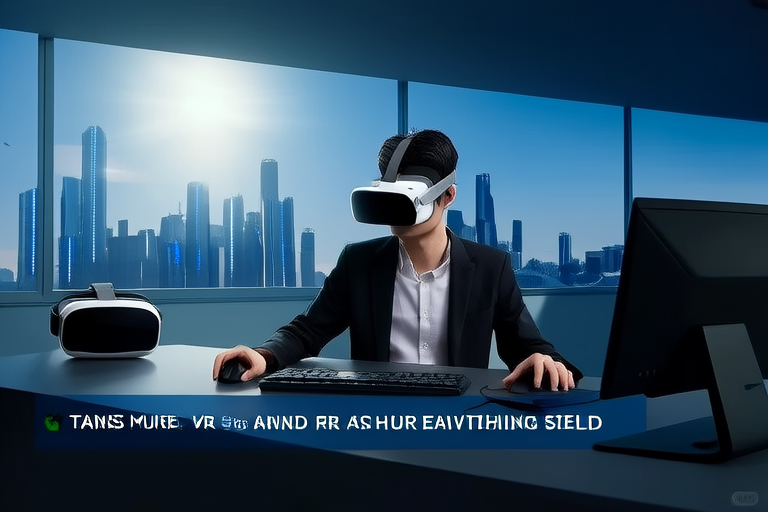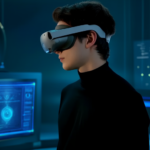Exploring the Future: How VR and AR Are Reshaping Our World
Introduction
In recent years, Virtual Reality (VR) and Augmented Reality (AR) have emerged as transformative technologies with the potential to redefine how we interact with the world. While VR immerses users in entirely digital environments, AR overlays virtual elements onto the real world, blending the two seamlessly. These technologies are no longer confined to the realms of gaming and entertainment; they are rapidly expanding into diverse sectors, reshaping industries, enhancing human experiences, and offering innovative solutions to complex challenges. As we explore their applications and implications, it becomes clear that VR and AR are not just tools for entertainment but powerful catalysts for societal change.
The Impact of VR and AR on Various Industries
Education
One of the most promising applications of VR and AR is in education. Traditional learning methods often struggle to engage students or provide hands-on experiences. VR allows learners to step into immersive environments, such as historical landmarks, distant planets, or microscopic worlds, making abstract concepts tangible. For instance, medical students can practice surgeries in a risk-free virtual setting, while engineering students can explore complex machinery in 3D. AR complements this by overlaying interactive diagrams, annotations, and 3D models onto textbooks or real-world objects, enabling deeper understanding. By democratizing access to experiential learning, VR and AR are bridging gaps in education and fostering innovation in teaching methodologies.
Healthcare
In healthcare, VR and AR are revolutionizing patient care, training, and treatment. Surgeons are using AR headsets to visualize patient anatomy during operations, improving precision and reducing risks. VR is being employed for pain management, where patients use immersive experiences to distract themselves from chronic pain or discomfort. Mental health professionals are leveraging VR to create controlled environments for exposure therapy, helping patients overcome phobias and PTSD. Additionally, these technologies are enhancing medical training by simulating rare conditions and procedures, ensuring practitioners are better prepared for real-life scenarios. The integration of VR and AR in healthcare is not only improving outcomes but also making treatments more personalized and accessible.
Entertainment
The entertainment industry has been at the forefront of adopting VR and AR, transforming how audiences consume content. VR gaming offers fully immersive experiences, allowing players to step into fantastical worlds and interact with them in unprecedented ways. Beyond gaming, AR is enhancing live events, concerts, and theme parks by adding interactive layers to physical spaces. For example, AR apps enable fans to unlock exclusive content during concerts or explore behind-the-scenes footage. Film and television are also experimenting with VR storytelling, giving viewers agency over narratives and creating deeply engaging experiences. As these technologies evolve, they promise to blur the lines between fiction and reality, offering limitless creative possibilities.
Business
In the business world, VR and AR are driving efficiency, collaboration, and innovation. Remote work has become increasingly common, and VR provides a solution by creating virtual meeting spaces where employees can interact as if they were in the same room. AR, on the other hand, is transforming retail by enabling customers to virtually try on clothes, visualize furniture in their homes, or test makeup products through smartphone apps. In manufacturing, AR assists workers by overlaying instructions onto machinery, reducing errors and speeding up processes. These technologies are not only streamlining operations but also enhancing customer experiences, making businesses more competitive in a rapidly changing market.
Potential Societal Implications
As VR and AR continue to evolve, their societal implications are becoming increasingly profound. On one hand, these technologies have the potential to foster greater inclusivity and accessibility. For example, individuals with mobility impairments can use VR to explore places they might never physically visit, while AR can assist those with visual or hearing impairments by providing real-time translations or audio descriptions. Moreover, VR and AR could enhance social connections by creating shared virtual spaces where people from different parts of the world can collaborate, learn, and play together.
However, there are concerns about the ethical and psychological impacts of prolonged immersion in virtual environments. Issues such as addiction, desensitization, and the blurring of reality and fantasy need to be addressed. Additionally, the widespread adoption of VR and AR could exacerbate existing inequalities if access to these technologies remains limited to affluent communities. Policymakers and developers must work together to ensure that these innovations benefit society as a whole without compromising individual well-being.
Challenges to Widespread Adoption
Despite their immense potential, several challenges hinder the widespread adoption of VR and AR. One major obstacle is cost. High-quality VR headsets and AR devices remain expensive, limiting accessibility for many consumers and businesses. Furthermore, the hardware required for optimal performance—such as powerful computers or specialized sensors—adds to the financial burden.
Technical limitations also pose significant hurdles. Current VR systems often suffer from latency issues, motion sickness, and restricted field-of-view, which detract from user experience. Similarly, AR faces challenges related to accuracy, battery life, and seamless integration with real-world environments. Developers must address these technical shortcomings to make VR and AR more practical and appealing.
Another challenge lies in content creation. Developing high-quality, engaging VR and AR experiences requires substantial investment in time, resources, and expertise. Without a robust ecosystem of diverse applications, the appeal of these technologies may remain niche. Additionally, privacy and security concerns arise as VR and AR collect vast amounts of personal data, raising questions about how this information is stored and used.
Conclusion
Virtual Reality and Augmented Reality are poised to reshape our world in ways previously unimaginable. From revolutionizing education and healthcare to transforming entertainment and business, these technologies are unlocking new possibilities across industries. Their potential to enhance human experiences, foster inclusivity, and drive innovation is undeniable. However, realizing this potential will require overcoming significant challenges, including cost barriers, technical limitations, and ethical considerations.
As we stand on the cusp of a new era defined by VR and AR, it is crucial to approach their development and implementation thoughtfully. By prioritizing accessibility, addressing societal concerns, and fostering collaboration between stakeholders, we can harness the transformative power of these technologies responsibly. The future shaped by VR and AR holds immense promise—a future where the boundaries between the physical and digital dissolve, empowering us to explore, learn, and connect like never before.


